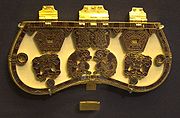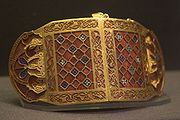
Purse Cover from Sutton Hoo Burial
Encyclopedia

Sutton Hoo
Sutton Hoo, near to Woodbridge, in the English county of Suffolk, is the site of two 6th and early 7th century cemeteries. One contained an undisturbed ship burial including a wealth of Anglo-Saxon artefacts of outstanding art-historical and archaeological significance, now held in the British...
site in Suffolk, England, found many exquisite artifacts in the remains of a royal ship burial. The excavation site contains a collection of burial mounds, and over the years the excavators discovered items that provided them with information about the Medieval Anglo-Saxon culture. One such object of artistic value, is a purse cover that was originally buried under Mound 1. About seven and a half inches long, this purse lid is decorated with beautiful gold ornament and garnet cloisonné, and was undoubtedly a symbol of great wealth and status.
Anglo-Saxon Culture
Although the Romans withdrew from Britain in about 410 CE, it wasn’t until about 450 CE that evidence exists of a new group of people inhabiting the area. Through burial sites like the one found at Sutton Hoo, historians can see that these new people wore different clothing, had different burial techniques, and had a different artistic style then the ancient Romans. Historical documents contain indications that the inhabitants came from places which they called Angeln and Saxony; therefore, it is only appropriate that historians have dubbed them Anglo-Saxons.As early as the seventh century, many different Anglo-Saxon
Anglo-Saxon
Anglo-Saxon may refer to:* Anglo-Saxons, a group that invaded Britain** Old English, their language** Anglo-Saxon England, their history, one of various ships* White Anglo-Saxon Protestant, an ethnicity* Anglo-Saxon economy, modern macroeconomic term...
kingdoms had sprung up, and even created their own monetary system and produced their own currency. Eventually during the ninth century, the kingdoms, facing trouble from Vikings of the East and North, were unified under Alfred the Great.
Sutton Hoo Purse Cover
One of the objects found at the Sutton Hoo burial site is a purse cover. It comes from the early seventh century Anglo-Saxon society at Sutton Hoo, and was most likely a symbol of great wealth and prominent status, as it is, to the extent of our knowledge, the most elaborate and luxurious one of its kind.The cover, or purse lid as it is sometimes known, would have been placed over a leather pouch that was filled with gold coins. It hung from one’s waist belt by the three hinges seen on top of it, and was fastened with a buckle made of gold. Much of the lid has decayed over the years, but it was probably made of whale-bone ivory, a very valuable item to the Anglo-Saxons. The most elaborate parts of this Sutton Hoo purse cover are the seven gold rimed garnet cloisonné
Cloisonné
Cloisonné is an ancient technique for decorating metalwork objects, in recent centuries using vitreous enamel, and in older periods also inlays of cut gemstones, glass, and other materials. The resulting objects can also be called cloisonné...
and millefiori
Millefiori
Millefiori is a glasswork technique which produces distinctive decorative patterns on glassware.The term millefiori is a combination of the Italian words "mille" and "fiori" . Apsley Pellatt was the first to use the term "millefiori", which appeared in the Oxford Dictionary in 1849...
glass designs that are set into it. In this particular art piece, the craftsman used a combination of very small and very large stones, a technique that could have, in Anglo-Saxon times, probably been able to connect the designs of the purse cover to the artist who created them. In fact, it was probably just one artist who crafted all of the metalwork for a single commission.
On the outside of the lid there are symmetrical images of a man surrounded by two wolves. In between these images are two more symmetrical figures, this time depicting an eagle swooping down upon its prey. To the ancient Anglo-Saxons, these images undoubtedly held great significance, but to us, as historians, it is very difficult to be sure of the symbolism in these figures. It is possible that the heraldic composition of the men and the wolves alludes to the family name of the Sutton Hoo ship burial- the Wuffingas, or Wolf's People. They could also, along with the eagle, exhibit power, heroism, and courage. Above the animal and human figures the artists inlaid abstract designs, which, when combined with animal figures, are the hallmark of art in western Europe during early medieval times.
Excavation
Sutton Hoo is a series of 6th-7th century burial mounds found in Suffolk, England. The first and also the largest mound, originally excavated in 1939 by Basil BrownBasil Brown
Basil John Wait Brown was a farmer, archaeologist, amateur astronomer and author who most famously discovered the buried ship at Sutton Hoo and excavated its sandy outline on the eve of war in 1939....
, contained a 90 feet (27.4 m) ship, and is supposedly the burial site of Raedwald, who was the leader of the Wuffing dynasty. It was in this mound that archaeologists discovered the elaborately decorated purse lid. The original excavation records of the mound were destroyed during World War II, and only pictures of the rivets in the sand remain as evidence. The excavated materials were sent to London, and restorations documentation of the objects found did not begin until the end of the war.
Decades later, starting in 1965 and ending in about 1971, the mound was excavated again, first by Rupert Bruce-Mitford
Rupert Bruce-Mitford
Rupert Leo Scott Bruce-Mitford was a British archaeologist best known for his multi-volume publication on the Sutton Hoo ship burial....
, and then by Paul Ashbee
Paul Ashbee
Paul Ashbee, was a leading British archaeologist, celebrated for his many excavations of barrows, or burial mounds, and for co-directing the Sutton Hoo digs from 1964 to 1972; he was perhaps less well known as president of the Just William Society, established in 1995 to celebrate the literary...
.
Between the years of 1986 and 1992, the Sutton Hoo Research Committee, under the leadership of Martin Carver
Martin Carver
Martin Oswald Hugh Carver FSA , is Emeritus Professor of Archaeology at the University of York, England, director of the Sutton Hoo Research Project and a leading exponent of new methods in excavation and survey. He specialises in the archaeology of early Medieval Europe...
, re-excavated Mound 2. At this time, archaeologists also excavated Mounds 5, 6, 14, 17, and 18. Here, Carter discovered thirty-nine burials. These 8th-11th century burials were, perhaps, execution burials, as the bodies that were spread around Mound 5 were in what was most likely the ship’s gallows.
Other Artifacts from Sutton Hoo

The buckle, the only damaged object from the Sutton Hoo excavations, was crushed beneath the sword that was fastened to the belt upon which it hung. Like the purse lid, the belt buckle also contains decorations made with the cloisonné technique. Also similar to the purse cover, are the shoulder clasps. These clasps are made with the cloisonné technique, as well, and they contain the same combination of abstract designs with animal figures as seen on the front of the lid. The boars depicted on these clasps were probably meant to remind the wearer of his strength and courageous qualities as a warrior. During Medieval times, the Anglo-Saxons saw boars as a symbol of protection for both men and women. Once again, one can see that this arrangement of both types of designs was truly the hallmark of art in western Europe during this time period. Even the sword found at the Sutton Hoo ship burial contains cloisonné inlay on its handle.
External links
- http://www.britishmuseum.org/explore/highlights/highlight_objects/pe_mla/s/shoulder_clasps_from_the_ship-.aspx British Museum
- http://www.britannica.com/EBchecked/topic/382708/millefiori-glass Britannica- Millefiori Glass
- http://www.britannica.com/EBchecked/topic/122026/cloisonne Britannica- Cloisonne
- http://penelope.uchicago.edu/~grout/encyclopaedia_romana/britannia/anglo-saxon/suttonhoo/suttonhoo.html University of Chicago
- http://www.suttonhoo.org/archeology.asp Sutton Hoo Archaeology

